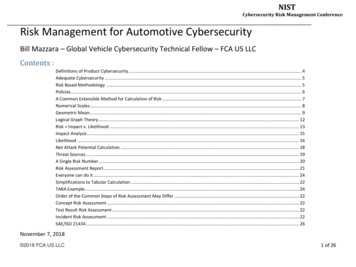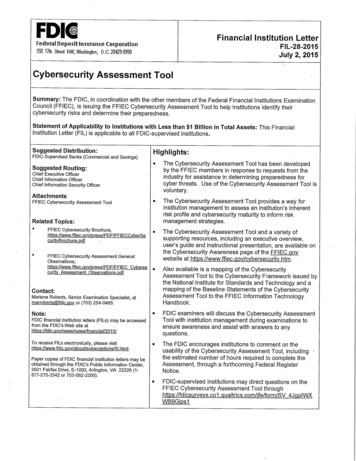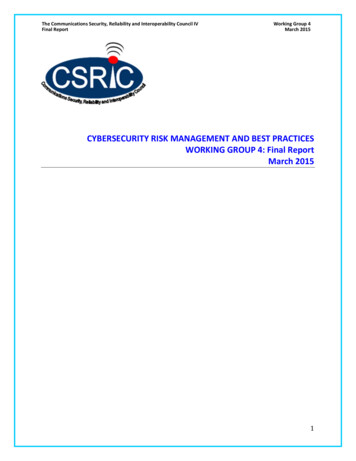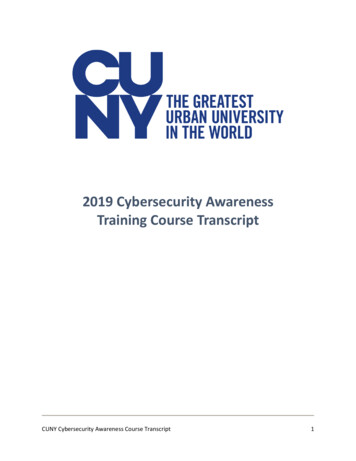
Transcription
BeOn Security Cybersecurity for CriticalCommunications SystemsL3Harris Technologies, Inc.WHITEPAPER
TABLE OF CONTENTSBeOn Security. 3Summary . 3Essential Security Requirements. 3Client and Application Security. 4Authentication Schemas. 4End-to-End Encryption. 4Over-the-Air Rekeying (OTAR). 4Data Security (Data At Rest). 4Airlink Encryption. 4Personally Identifiable Information (PII) Protection. 5Event History Retention Controls. 5Network Security. 6LIST OF FIGURES AND TABLESFigure 1: BeOn Network Infrastructure. 3Figure 2: Scalable Hosted/Integrated Solution. 6Table 1: Cybersecurity Controls. 72 BeOn Security Whitepaper
BeOn SecuritySUMMARY IP-based technologies are prevalent in wireless communications systems nowmore than ever. This offers flexibility, broader practical use case scenariosand greater economy of scale. Other benefits include a common backbone andinfrastructure, commercially available standardized products, common supportand maintenance, and adaptability to emerging technologies.Cybersecurityfor CriticalCommunicationsSystemsAs critical communications systems interconnect with enterprise environments,overall agency needs must be evaluated. Interoperability typically increases anorganization’s exposure factor, attack surface and threat vectors that collectivelyincrease risk. For this reason, stringent cybersecurity controls are implementedusing a Defense-in-Depth strategy throughout the BeOn system design.L3Harris recognizes the importance of cybersecurity to wireless communicationssystems and enterprise IP-based systems. The following sections identify therequirements and offerings to meet these important system design securityrequirements in a cost-effective manner.ESSENTIAL SECURITY REQUIREMENTSThe BeOn network infrastructure and client applications fully integrate with L3HarrisLand Mobile Radios (LMR) and leverage the enhanced data capability ofLTE to provide Push-to-Talk (PTT) services to users on both commercial andprivate broadband networks, including Long-Term Evolution (LTE) networks.NETWORK SWITCHINGCENTERVIDA DISPATCHCONSOLE (OPTIONAL) BeOnACCESSPOINTBeOnCLIENTOTAR KEY MANAGEMENTFACILITY (OPTIONAL)ENTERPRISEWANCOMMERCIALCELLULAR NETWORK VIDA CORE ELEMENTS BeOn NETWORK ELEMENTS ADDITIONAL L3HARRIS NETWORK ELEMENTSADMINISTRATIONMANAGEMENTP25 SITEP25 SUBSCRIBERP25 ISSITO OTHERVENDORNETWORKSGR160007v6Figure 1: BeOn Network InfrastructureCybersecurity for Critical Communications Systems 3
CLIENT AND APPLICATION SECURITYAuthentication SchemasBeOn supports mutually exclusive system- and application-level passwordprotection using a discretionary access control model. The application password isindependent from the administrator-issued Voice, Interoperability, Data and Access(VIDA ) password and separate from the device password. A system administratorcan specify system-wide, on-device password storage options.User authentication by the system may optionally use credentials generatedby a Key Management Function (KMF) using the same mechanisms as TIA-102 LinkLayer Authentication.End-to-End EncryptionBeOn supports TIA TR8.8 P25-compatible Advanced Encryption Standard(AES) end-to-end voice encryption. BeOn clients can make encrypted callsto individuals or talkgroups that include standard Project 25 (P25) radios,consoles or other BeOn clients in the same crypto net (two or more end userswho share an encryption key that they use to communicate with each other).Voice payload is encrypted end-to-end (Phone-Phone/Phone-Radio) using thesame module as the P25 radio.The universal encryption key is manually loaded initially; encryption keyscan be subsequently changed over-the-air using a Key Management Facility.Over-the-Air Rekeying (OTAR)BeOn supports TIA TR8.8 P25-compatible rekeying. This allows a crypto-officerthe ability to rekey devices over the air.Data Security (Data At Rest)On devices that support application partitions, all personally identifiable data isstored in the application partition. This includes contact lists, group lists, settingsand so on.Airlink EncryptionThe Airlink encryption feature encrypts all data and signaling between theBeOn client and the BeOn access point in the network using the DatagramTransport Layer Security (DTLS) protocol. BeOn contacts are retrieved usingTransport Layer Security (TLS). The same cipher suites are used for both DTLSand TLS: LS RSA WITH AES 256 GCM SHA384 for Android and the BeOnWindows Client, and TLS RSA WITH AES 256 CBC SHA for iOS.4 BeOn Security Whitepaper
The feature supports either an authority-issued, customer installed certificate or acustomer generated certificate.A customer-generated certificate requires installing the public key on eachBeOn client device using standard client device operating system mechanisms,such as email, device management push, HTTP key file download or side-load.The Airlink encryption feature can be enabled or disabled on a system-widebasis.Personally Identifiable Information (PII) protectionContact list information will not be stored in permanent storage outside the VIDAcore, and will be transferred via TLS or equivalent to the client. Once on the client,the data will be stored in separate user-storage where supported.Event History Retention ControlsA system-wide administrator option controls retention of on-client event history,including voice recordings.Cybersecurity for Critical Communications Systems 5
NETWORK SECURITYA comprehensive Defense-in-Depth security strategy is employed throughoutBeOn ’s security architecture to include the U.S. Department of Defense UnifiedCapabilities Approved Products List (DoD UC APL) and/or Common Criteria(CC) tested security controls (i.e., firewalls, Intrusion Prevention System (IPS),whitelisting, system hardening, auditing, virtualization, change management, faulttolerance and backup).NAT (Network Address Translation) is implemented for BeOn to reduce networktransparency and is implemented on external connections facing the customerpremise or internet. NAT is permitted and enforced only on specific User DatagramProtocol (UDP) ports relative to BeOn.Implicit permit ingress/egress Access Control Lists (ACLs) are applied on thepremise firewall for all traffic on the outside interface.Additionally, implicit access rules are defined in a Demilitarized Zone (DMZ) to onlypermit interesting traffic between BeOn and VIDA applications. The BeOn solutionis hosted in a DMZ of the VIDA Network with a robust security protection profile.Computing and network components have DoD Security Technical ImplementationGuides (STIG) applied at Mission Assurance Category (MAC-2)/sensitive levels.The following diagram is a high-level proposed concept design for a scalable,hosted/integrated solution.NETWORK SWITCHINGSERVERBeOnACCESSPOINTINTERNETREGIONAL NISTRATIONSERVERSYMPHONY DISPATCH CONSOLEGR16008v6Figure 2: Scalable Hosted/Integrated Solution6 BeOn Security Whitepaper
Inherited cybersecurity controls implemented within the hosting LMR environments for BeOn:SECURITY CAPABILITIESDESCRIPTIONSAccess Control› Active directory services› Certificate authority› Centralized logging of system level and security events› Two-factor authentication (Quest Defender)System Hardening› Apply baseline security controls on network and system components, including servers,workstations and network routers› Remove unused services, daemons, unnecessary rights from user and service logins› Configure secured web browsers› Utilize secured remote administration tools› Apply the latest third-party security patchesSoftware Update Management Server (SUMS)› Automated patch management platformHost-based Intrusion ProtectionSystem (HIPS)› Threat detection at server and workstation levels› Industry-leading defense against targeted attacks, spyware, rootkits› Zero-day attack security via McAfee Complete Endpoint Protection› Signature, anomaly and heuristic analysis available for the installed hostsNetwork Intrusion Detection (NIDS)› Monitors traffic and alerts the system administrator of signature-based violations› Collects network traffic using various network sensors› Network sensors aggregate network traffic across multiple hosts (to which the networkis attached)Disaster Recovery› Disaster recovery with centralized backup recovery platform› Disaster recovery redundancy with cross-vaultingEncrypted Communication Links› Voice-traffic encryption between user devices and dispatch consoles› Application-level encryptionTable 1: Cybersecurity ControlsCybersecurity for Critical Communications Systems 7
Non-Export Controlled InformationL3Harris is a registered trademark of L3Harris Technologies.Trademarks and tradenames are the property of their respective companies. 2021 L3Harris Technologies, Inc. 04/2021 CS-PSPC WP1310D
End-to-End Encryption BeOn supports TIA TR8.8 P25-compatible Advanced Encryption Standard (AES) end-to-end voice encryption. BeOn clients can make encrypted calls to individuals or talkgroups that include standard Project 25 (P25) radios, consoles or other BeOn clients in the same crypto net (two or more end users










